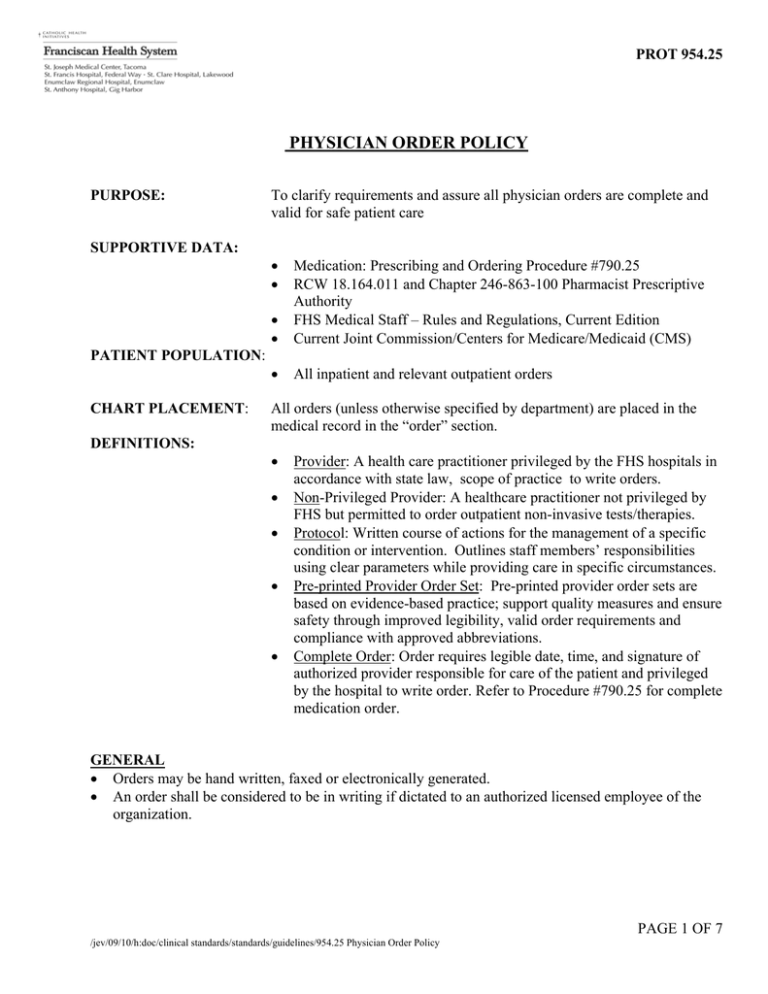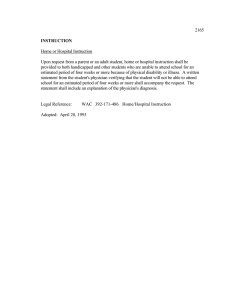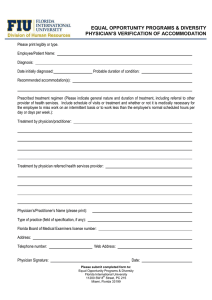Physician Order Policy - CHI Franciscan Health
advertisement

PROT 954.25 PHYSICIAN ORDER POLICY PURPOSE: SUPPORTIVE DATA: To clarify requirements and assure all physician orders are complete and valid for safe patient care • • • • Medication: Prescribing and Ordering Procedure #790.25 RCW 18.164.011 and Chapter 246-863-100 Pharmacist Prescriptive Authority FHS Medical Staff – Rules and Regulations, Current Edition Current Joint Commission/Centers for Medicare/Medicaid (CMS) • All inpatient and relevant outpatient orders PATIENT POPULATION: CHART PLACEMENT: DEFINITIONS: All orders (unless otherwise specified by department) are placed in the medical record in the “order” section. • • • • • Provider: A health care practitioner privileged by the FHS hospitals in accordance with state law, scope of practice to write orders. Non-Privileged Provider: A healthcare practitioner not privileged by FHS but permitted to order outpatient non-invasive tests/therapies. Protocol: Written course of actions for the management of a specific condition or intervention. Outlines staff members’ responsibilities using clear parameters while providing care in specific circumstances. Pre-printed Provider Order Set: Pre-printed provider order sets are based on evidence-based practice; support quality measures and ensure safety through improved legibility, valid order requirements and compliance with approved abbreviations. Complete Order: Order requires legible date, time, and signature of authorized provider responsible for care of the patient and privileged by the hospital to write order. Refer to Procedure #790.25 for complete medication order. GENERAL • Orders may be hand written, faxed or electronically generated. • An order shall be considered to be in writing if dictated to an authorized licensed employee of the organization. PAGE 1 OF 7 /jev/09/10/h:doc/clinical standards/standards/guidelines/954.25 Physician Order Policy PROT 954.25 PHYSICIAN ORDER POLICY GENERAL - CONTINUED • • • • • • • • The provider’s order must be documented completely with sufficient content to clearly convey the provider’s intent. “PRN” orders must have indications included in the order. Blanket orders to “resume previous orders” or “resume pre-op meds” will not be accepted. After the authorized provider has completed the orders, the RN or other authorized staff is responsible to promptly and accurately transcribe all written orders. The RN (or other authorized staff) transcribing the order must include his/her signature, the date and time of the transcription and credentials. An RN may delegate this duty to a trained health unit coordinator under his/her direction. Each order transcribed onto another form or MAR by a health unit coordinator must be checked carefully for accuracy signed, dated, timed, and co-signed, dated and timed by the RN. All STAT orders must be shown immediately to the appropriate RN. All orders are canceled upon entry to the surgical suite. New orders must be written after surgery. Orders of inpatients going for scheduled for non-surgical procedures off the unit should not be discontinued unless specifically ordered by the physician. NPO and Code Status are clarified for the procedure if indicated. Clarification of any potential change of orders while the patient is off the unit is discussed during the hand-off communication and the attending physician is notified if needed. Inpatient Orders generated from outside the hospital must be dated, timed and authenticated by a qualified and authorized practitioner. Some written orders to implement a pre-printed provider orderset or protocol may be transcribed and implemented by a RN, pharmacist or other authorized practitioner. Examples include a written order for blood, code status, protocol per pharmacy, or RN PICC placement. The appropriate order set is pulled; the order is transcribed clearly by the RN/pharmacist, dated, timed and implemented (5-22-10 1700 Initiated per Dr. Jones order/J. Nelson RN). On-Call/Covering Providers-Any provider responsible for the care of the patient and authorized by law and scope of practice are permitted to write patient care orders. On-call or covering providers responsible for the patient may date, time and authenticate telephone/verbal orders of physicians or their designees. Specialty Departments or Services with other regulatory requirements must have defined and written procedures for orders. CLARIFICATION OF ORDERS: • Orders that are unclear must be clarified prior to implementation. When the provider is not available, orders subsequently clarified by phone are processed and transcribed as TORB and written in the medical record 1-4-10- 1700 TORB Clarification order R. Johnson, MD/J. Nelson RN. PAGE 2 OF 7 /jev/09/10/h:doc/clinical standards/standards/guidelines/954.25 Physician Order Policy PROT 954.25 PHYSICIAN ORDER POLICY TELEPHONE /VERBAL ORDERS • Verbal and telephone orders from credentialed and privileged members of the Medical Staff may be accepted by a registered nurse, licensed practical nurse, physician assistant, pharmacist, respiratory therapist, physical therapist, occupational therapist, speech therapist, dietician, social worker, or utilization management staff. The authorization of this regulation , which allows therapists, pharmacists, social workers and utilization management staff to accept verbal and telephone order, shall only apply to those orders directly related to their areas of expertise and scope of practice. • Telephone orders for inpatient care from physician/provider offices may only be accepted from licensed staff authorized by scope of practice and licensed to write orders. • Telephone/verbal orders must be written down and read back to the ordering provider per hospital policy to ensure accurate understanding and transcription. The letters T.O. R.B. or V.O.R. B. are documented followed by the provider name and credential and the authorized person receiving the order (i.e., TORB Dr Jones/J. Nelson, RN). • Authentication of telephone/verbal orders shall be performed as soon as possible but in no case longer than 48 hours after they are received. The practitioner must separately date and time this authentication even though there will already be a date, time on the initial TORB/VORB noting when it was accepted. Authentication of a telephone order may be written, electronic or faxed. • Any qualified practitioner responsible for the care of an inpatient and privileged by the hospital may give a telephone order. • For multiple page ordersets, the RN must document on each page of the orderset what the provider has individualized for the patient and date, time and sign the last page of the orders as telephone order. The ordering provider shall date, time and sign the last page of the orderset denoting his/her review of the entire orderset. • Verbal orders (face-to-face) are to be used infrequently, and should only be used to meet the urgent needs of the patient when it is not feasible for the ordering physician to immediately communicate the order in written or electronic form. • RNs or other licensed staff receiving verbal orders during surgery, procedures, or other urgent clinical situations must repeat back and verify all verbal orders. The verbal orders are written down and authenticated as soon as possible by the ordering provider. Verbal orders received by RNs during surgery or procedures or authorized licensed staff must repeat back the order and verify the order if impractical due to urgency of patient condition to write down and read back during the procedure. All verbal orders are written down by the RN and authenticated as soon as possible after the procedure. • Unit and department staff are expected to flag all telephone/verbal orders to alert physician and providers that date, time and signature is needed. A stamp should also be affixed below each order prompting the physician/provider to date, time and authenticate each order within 48 hours. Flags should be placed for physician co-signatures. • Physicians, unit and department staff should assure all orders are dated, timed and authenticated PRIOR to discharge. PAGE 3 OF 7 /jev/09/10/h:doc/clinical standards/standards/guidelines/954.25 Physician Order Policy PROT 954.25 PHYSICIAN ORDER POLICY CO-SIGNATURES FOR ADVANCED PROFESSIONAL PHDS, RESIDENTS, STUDENTS • Co-signatures by sponsoring physicians for Advanced Registered Nurse Practitioners and Certified Physician Assistants are not required for those providers privileged to write orders. • Advanced Professional PhDs require a co-signature from sponsoring physician on Inpatient orders within 24 hours. • Residents and students require co-signatures with date and time. • Unit and department staff are expected to flag all entries that require date, time and co-signature of sponsoring physician. • Units and departments should assure all orders are co-signed with date and time PRIOR to discharge. PRE-PRINTED PROVIDER ORDER SETS • All pre-printed orders shall be created and approved by the appropriate FHS IDT or Leadership Team and provided on FHS forms. The FHS pre-printed orders have been reviewed, approved and aligned with medical staff rules and regulations, hospital policy, Joint Commission, CMS, Department of Health, FHS formulary and other relevant regulatory agencies. • All relevant order sets involving medication are additionally reviewed by Pharmacy and the PT&T Committee and as needed the Medication Safety Leadership Team to ensure appropriate medication prescribing and ordering practices are followed. • The Pre-Printed Provider Order Set process is supported centrally by the Clinical Effectiveness Division and its oversight Provider Orderset Standardization and Implementation Workgroup (POSSI). • The use of pre-printed orders must be individualized, documented as an order in the patient’s medical record and authenticated by a practitioner responsible for the care of the patient and authorized by the Medical Staff and state law scope of practices. • The registered nurse verifies that the orders have been processed and indicates the time, date and signature next to the order. • A Registered nurse may complete the order sets through use of verbal or telephone orders from an authorized practitioner provided that the orders are read back to the practitioner per policy. • Items on the order set that do not have a box to check or are pre-checked are intended to be used for all patients. These items may be denoted by a bullet point or dash. • Items that have a checkbox in front of them are only carried out if the box is checked. This provides customization to fit the individual patient needs and/or practitioner preference. • Items without a checkbox or pre-checked that the physician does not want ordered must be lined out and initialed. • Note: Some of the pre-printed orders have multiple choices within the individual medication sections as denoted by a line preceding the medication. Examples include oral/IV analgesics or antiemetics. If there is no guidance provided as to the preferential order for medication administration, the provider must specify his/her preferential order by inserting 1, 2, etc., on the lines of the desired medications. If the provider selects multiple medications within a section and does not specify a preferential order, the nurse must contact the provider and clarify the order. PAGE 4 OF 7 /jev/09/10/h:doc/clinical standards/standards/guidelines/954.25 Physician Order Policy PROT 954.25 • • • • • PHYSICIAN ORDER POLICY For multiple page ordersets, the practitioner must initial each page of the orderset and date, time and sign the last page of the orders. Some pre-printed order sets refer the clinical team to additional order sets or protocols, such as the PCA (Patient Controlled Analgesia), Alcohol Withdrawal, Pneumonia orders. The additional ordersets will be pulled, individualized by the physician and implemented per hospital order policy. Some pre-printed order sets refer the clinical team to additional order sets or protocols that have predetermined parameters or clearly defined items that may be implemented by pharmacy protocol or nursing and do not require an additional physician order to implement. Examples include: Code Status, PICC placement, or over-the-counter medications. In these situations, the nurse will complete the additional order set/protocol and date, time and authenticate the order (i.e., Initiate per Dr. Jones order/J. Nelson RN). Pre-printed Provider Order set Pilot- may be established for 90 days by the expert user leadership team and approved for use by the Chief Medical Officer, Service Medical Director and Pharmacy Leadership representative (or designee) to POSSI. An Emergency Order set Change Authorization Form is completed and approved prior to implementation. The order set pilot may be used until the next appropriate Leadership IDT has officially approved the changes. Pre-printed order sets are available on line and through the FHS Intranet home page. Nurse Initiated Orders (NIOs) • Nurse initiated orders are indicated for the purposes and promotion of effective emergency care, timely and necessary care and evidence based safety practices. Examples include restraints, rapid response team, emergency department procedures, and time sensitive care protocols approved by the medical staff. • To ensure the nurse is not making clinical decisions outside his/her scope of practice, clear parameters and actions for the implementation of the protocol must be delineated in the order. • All nurse initiated protocols are approved by the appropriate IDT/LT and the Medical Executive Committee. • Nurse initiated protocols must be dated, timed and authenticated by a responsible practitioner promptly. Each nurse initiated order must have defined time frames for authentication but not to exceed 48 hours. • Exception: Influenza and pneumococcal polysacchiaride vaccines may be administered per physician-approved hospital protocol and do not required authentication. • Exception: Nursing referrals triggered during the admission screening assessment that meet specific criteria for interdisciplinary referrals may be written as nursing orders to initiate the referral and do not require physician co-signatures. Nursing referrals that do not required a physician order include dietician, pastoral care, social worker, care management, interpreter or translator. Example: Nursing Order for Nutrition Referral/J Nelson RN. MEDICATION ORDERS (Refer to Prescribing and Ordering Procedure # 790.25) • Medication orders must be printed and authenticated by providers granted prescribing privileges by the organization. Cursive writing is prohibited for medication orders. (RCW 69.41.010). PAGE 5 OF 7 /jev/09/10/h:doc/clinical standards/standards/guidelines/954.25 Physician Order Policy PROT 954.25 • PHYSICIAN ORDER POLICY All medication orders must contain the medication name, dosage, frequency, time and route of administration. PHARMACIST INITIATED ORDERS/PROTOCOLS • Pharmacy driven pre-printed order sets/protocols are authorized under WA Board of Pharmacy scope of practice. RCW 18.164.011 and Chapter 246-863-100 Pharmacist Prescriptive Authority. • Pharmacist orders are authorized under RCW 18.164.011 and Chapter 246-863-100 Pharmacist Prescriptive Authority. This State of Washington RCW and WAC permit pharmacists to order medications under Collaborative Drug Therapy Agreements with physicians. FHS has Collaborative Drug Therapy Agreements that have been accepted by the Washington State Board of Pharmacy and have been approved by the Franciscan Health System PT&T Committee. The list of authorizing prescribers includes all those physicians practicing at Franciscan Health System. All pharmacists employed by Franciscan Health System hospitals are eligible to participate in the FHS Collaborative Drug Therapy Agreements. • Co-signatures from the authorizing prescriber are not required. • Processing of pharmacist orders fall within the General, Clarification of Orders, Telephone/Verbal Orders, Pre-Printed Provider Orders Sets, and Medication Orders sections of this guideline as for any Physician orders. FAXED ORDERS • Facsimile orders are accepted if legible, dated, timed and authenticated by an authorized provider. • Patient health information is not allowed on the cover sheet of the facsimile. • Facsimile orders have documentation to reflect the identity of the author, the date, time and authentication when the order has been transcribed and implemented. ELECTRONIC MEDICAL RECORD ORDERS • The identity of the author of the order is established. The electronic signature (e-signature) displays the e-signature, author’s name, title, date, and time of application. The authentication statement is identified in the document. Examples include, but are not limited to “Electronically signed by”, “Approved by”, “Completed by”, “Authenticated by”, Confirmed by”, Validated by”, and Verified by”. • The order must meet the requirements of a valid and complete order. OUTPATIENT ORDERS • Outpatient services that provide direct patient care define the requirements for obtaining a completed order. • Outpatient diagnostic services: Refer to department specific referral and order procedures. • Outpatient services define the time frames for series or continuing therapy orders as determined by patient setting, patient condition and type of procedures or therapy. • Duration of the Order: An order for ongoing treatment has an end date for treatment. Treatment extending over 90 days but less than a year requires provider chart notes documenting effects of PAGE 6 OF 7 /jev/09/10/h:doc/clinical standards/standards/guidelines/954.25 Physician Order Policy PROT 954.25 PHYSICIAN ORDER POLICY • treatment, active participation and patient management for the treatment provided. Treatment extending over a year will require a new order. Refer to Department specific procedures for specialty areas. Triggers for reporting or communicating with the ordering provider during the series/continuing therapy are defined in department standards to ensure timely and safe care. EMERGENCY DEPARTMENT TRANSITION ORDERS • Emergency Transition Orders (#628) are initiated by an Emergency Department physician and are intended as interim patient care orders until the admitting physician has been contacted and the admission orders have been reconciled. • The Emergency Physician must Check A or B options on the orderset and authenticate with date, time and signature. • The Admitting Physician may continue or cancel the transition orders as written, modify the orders and/or provide additional orders on a separate sheet. NURSING 24-HOUR CHART ORDER CHECK • Inpatient nursing units have processes for 24 hour review and checks for order accuracy and appropriate follow up. APPROVAL REVIEW REQUIRED REVIEW DISTRIBUTION CROSS REFERENCE 08/10, 09/10 09/2013 Medical Staff, POSSI, Nurse Practice Council Regional Clinical Standards Manual PAGE 7 OF 7 /jev/09/10/h:doc/clinical standards/standards/guidelines/954.25 Physician Order Policy


